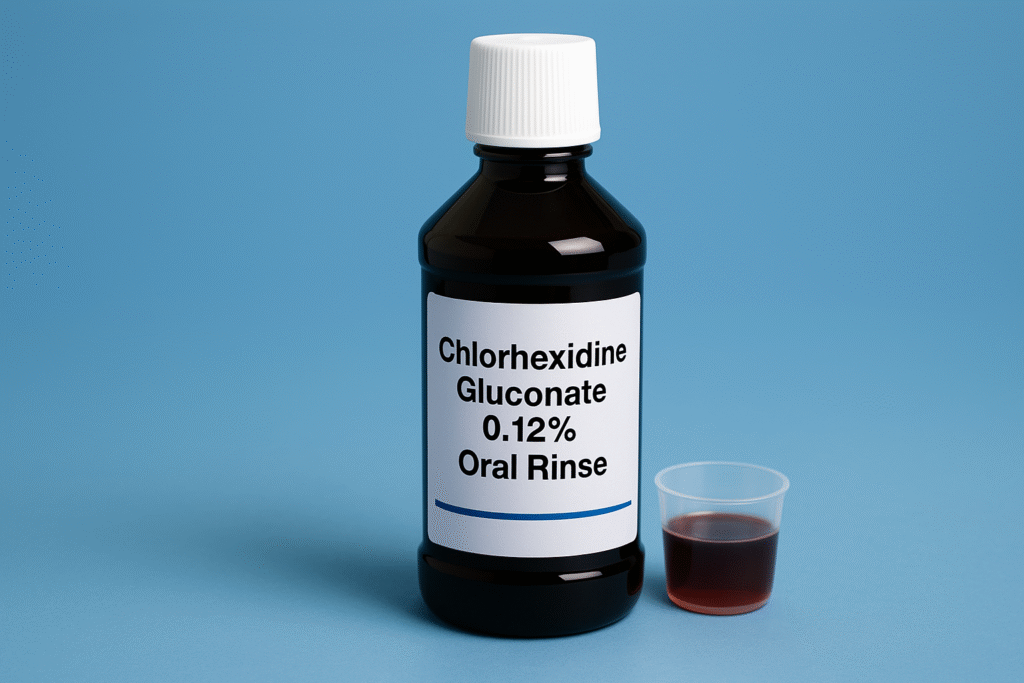Chlorhexidine gluconate is a chemical antiseptic used in many healthcare settings, particularly for oral hygiene. The 0.12% solution is the standard concentration used for mouth rinses in the United States. It’s designed to kill and inhibit the growth of bacteria, thus reducing plaque formation, gingival inflammation, and bleeding gums.
It is usually dark brown in color and has a somewhat bitter or medicinal taste. Despite its strong flavor, the results it delivers make it one of the most recommended mouthwashes in dental care.
The Science Behind Chlorhexidine Gluconate
Chlorhexidine works by disrupting the bacterial cell membrane. It binds to negatively charged bacterial surfaces, leading to leakage of intracellular components and eventually causing the bacteria to die. It is effective against a broad spectrum of microbes, including gram-positive and gram-negative bacteria, yeasts, and some viruses.
Because of its substantivity—its ability to bind to oral surfaces and be gradually released over time—chlorhexidine gluconate provides long-lasting protection, sometimes up to 12 hours.
Key Benefits of Chlorhexidine Mouthwash
-
Reduces Plaque Accumulation: It significantly lowers plaque levels, even in hard-to-brush areas.
-
Prevents Gingivitis: Regular use can stop gum inflammation and bleeding.
-
Speeds Up Post-Surgical Healing: Useful after tooth extraction or periodontal surgeries.
-
Controls Oral Infections: Effective against various bacterial infections in the mouth.
-
Improves Oral Hygiene: Especially for people with limited manual dexterity or undergoing orthodontic treatment.
When and Why Dentists Recommend It
Dentists typically prescribe this rinse for patients struggling with:
-
Gingivitis
-
Periodontitis
-
Post-operative wound care
-
Orthodontic appliance irritation
It’s a short-term solution rather than a daily-use product. Typically, it’s used for a 7–14-day period to manage acute issues or post-surgical care.
How to Use Chlorhexidine Gluconate Correctly
Using it properly maximizes benefits and minimizes risks:
-
Rinse with 15 mL of the solution for 30 seconds.
-
Avoid eating, drinking, or rinsing your mouth for 30 minutes after use.
-
Use it twice daily, typically after brushing.
-
Do not swallow the rinse.
Improper use, such as overuse or swallowing the solution, may lead to side effects or reduced efficacy.
Dosage Instructions for Safe Use
Adults and children over 12 should rinse with 15 mL twice a day. For children under 12, a healthcare provider should be consulted. Avoid using it more than twice daily unless specifically advised by your dentist.
Side Effects and Safety Precautions
Although chlorhexidine gluconate is generally safe, it can cause:
-
Tooth and tongue staining (temporary)
-
Altered taste perception
-
Oral mucosa irritation
-
Dry mouth
-
Increased tartar formation in some users
These effects are usually reversible once use is stopped. Avoid prolonged use beyond your dentist’s recommendation.
Common Myths About Chlorhexidine Gluconate
Some believe it can replace brushing—false. Others assume it’s harmful due to its staining potential—not quite. While side effects exist, they are manageable and often outweighed by the benefits when used correctly.
Is It Safe for Long-Term Use?
Long-term use is discouraged due to potential side effects like staining, tartar buildup, and taste alteration. It should only be used long-term under a dentist’s supervision.
Comparing Chlorhexidine with Other Mouthwashes
| Feature | Chlorhexidine Gluconate | Cosmetic Mouthwash | Fluoride Rinse |
|---|---|---|---|
| Antimicrobial | ✅ Strong | ⚠️ Mild | ⚠️ Mild |
| Prescription Required | ✅ Yes | ❌ No | ❌ No |
| Stains Teeth | ⚠️ Yes (temporary) | ❌ No | ❌ No |
| Prevents Gingivitis | ✅ Yes | ⚠️ Limited | ⚠️ Limited |
Can Chlorhexidine Replace Brushing?
No. Brushing and flossing remain the cornerstones of oral hygiene. Chlorhexidine is a supportive therapy, not a substitute. Think of it as a backup singer, not the lead vocalist.
Who Should Avoid Chlorhexidine Gluconate?
-
Individuals with a history of allergic reactions to the ingredient
-
Children under 12 without dental supervision
-
People with mouth ulcers or open wounds unless directed by a dentist
Using Chlorhexidine After Dental Surgery
It is a go-to rinse after oral surgeries such as:
-
Tooth extractions
-
Implant placement
-
Periodontal surgeries
It helps reduce infection risk and promotes tissue healing, often making post-op recovery smoother.
Chlorhexidine Gluconate for Gingivitis Treatment
Gingivitis is one of the top uses for this rinse. Within days of use, patients report:
-
Reduced gum bleeding
-
Less inflammation
-
Fresher breath
-
Improved oral comfort
Dentists often prescribe a 2-week regimen, followed by a reassessment.
Effects on Plaque and Tartar Buildup
It dramatically reduces plaque formation and retards the mineralization process that leads to tartar. However, professional cleaning is still needed to remove existing tartar.
Taste Alteration and How to Handle It
A common side effect is a bitter or metallic taste. This usually fades after discontinuation. Rinsing with water after 30 minutes or chewing sugar-free gum may help mask it.
Allergic Reactions: What to Watch Out For
Rare but possible. Symptoms might include:
-
Swelling of the tongue or throat
-
Difficulty breathing
-
Rash or itching
If any of these occur, stop use and seek immediate medical help.
Mixing with Other Oral Products: Dos and Don’ts
Avoid using toothpaste or whitening agents immediately before or after rinsing. They can deactivate chlorhexidine. Wait at least 30 minutes after brushing before use.
Pediatric Use: Is It Safe for Kids?
Generally not recommended for children under 12 unless advised by a healthcare professional. Risk of ingestion and improper use is higher among younger children.
How Long Should You Use Chlorhexidine Rinse?
Most dental professionals advise using it for no more than 2 weeks unless under close supervision. Prolonged use increases the risk of staining and taste changes.
Storage Guidelines and Product Shelf Life
Store at room temperature, away from direct sunlight. Do not freeze. Check the expiration date and avoid using it past that point for safety and effectiveness.
FAQs
Is chlorhexidine gluconate 0.12 oral rinse available over the counter?
No. It requires a prescription from a dentist or physician in most countries.
Does it kill COVID-19 or other viruses?
It may reduce some viral load but is not a substitute for antiviral treatments or precautions.
Can pregnant women use chlorhexidine rinse?
Yes, but only under the guidance of a dentist or physician.
Will it whiten my teeth?
No. It may cause temporary staining but does not have whitening properties.
Is it vegan or cruelty-free?
Check with the specific manufacturer. Formulations and testing policies vary.
Can I drink water immediately after using it?
No. Wait at least 30 minutes to ensure effectiveness.
Conclusion
Chlorhexidine gluconate 0.12 oral rinse stands out as a powerful ally in the fight against gum disease and poor oral hygiene. While it comes with a few caveats—like taste alteration and staining—its benefits far outweigh the risks when used correctly and for short periods. It’s not an everyday rinse, but when prescribed, it serves a highly effective purpose in restoring oral health and controlling infections.
For those navigating post-surgical healing, severe gingivitis, or plaque control, this rinse might just be your secret weapon. Always use it under dental supervision and don’t let it replace brushing and flossing—your true dental hygiene MVPs.


